It looks like you're using an Ad Blocker.
Please white-list or disable AboveTopSecret.com in your ad-blocking tool.
Thank you.
Some features of ATS will be disabled while you continue to use an ad-blocker.
share:

Hello...
Make no mistake, We as a species are about to embark into unknown territory. Guided only by our will and a insatiable thirst for progress, profit and a desire to control not only the world around us but each other. I'm sure many do not like the sound of that but in one way shape or form we all are responsible. Don't like Air pollution? Stop driving your car or take fossil fuel powered public transportation, Stop shopping at markets that have your food 'GMO or supposed Organic' trucked in. Don't like the wars fought in the Middle East over oil for big corporation profits? Stop buying their fuels.
Over the past few years there have been a few threads on the topic of Human Augmentation. I thought I'd try to bring a fresh new angle to the topic so, as not to repeat the already known or discussed aspects. Too many believe this is in the realm of fanciful science fiction but the reality of it is much more ominous and closer than many either simply cant comprehend or for whatever reason care to investigate what is technologically speaking just around the proverbial corner. It will get a good deal more prevalent than we can possibly imagine and potentially a threat to our own species existence. Don't think Humanity is past this type of thinking, not for a second. Remember, no sooner had they split the Atom that it was used to vaporize human beings.
Back in the days of my youth we read about and watched shows like The Six Million dollar man and wonder if Androids Dream of Electric Sheep?. Let's begin by looking at the world we find ourselves in presently with ever increasing R & D spending and development.
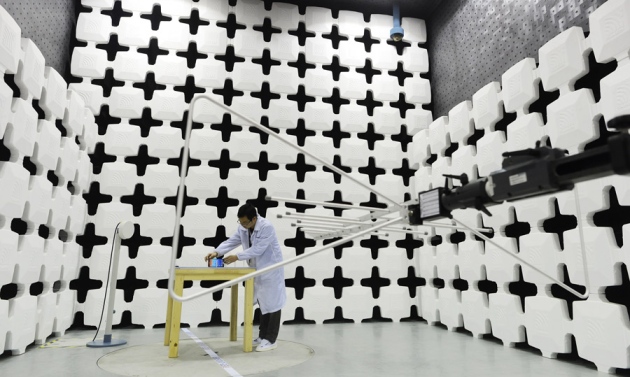
Reforms to commercial and academic research systems still needed despite reaching spending milestone, say scientists.
By pouring cash into science and technology faster than its economy has expanded, China has for the first time overtaken Europe on a key measure of innovation: the share of its economy devoted to research and development (R&D).
In 2012, China invested 1.98% of its gross domestic product (GDP) into R&D — just edging out the 28 member states of the European Union (EU), which together managed 1.96%, according to the latest estimates of research intensity, to be released this month by the Paris-based Organisation for Economic Co-operation and Development (OECD).
China seems to be pouring it on hot and heavy with R & D.

What we seem to be having is a good old fashion Arms race of sorts. All the major players in the world both developed and emerging are increasing their R & D budgets. This will only lead to even more advancements in all fields of present and future developments and Human Augmentation is very much on the table.
As the miniaturization of electronics, increases in NANO technologies, bio and chemical engineering funding continues to increase we will see many wonderful developments to be sure. I question though. Have we enough laws and regulations in place to prevent or at least slow down any potential catastrophic abuses either by corporations or Governments?
It's no secret Military and Scientific institutions and labs are in hot pursuit of the next Greatest gadget/application giving the edge either on the battlefield or the greater market share. Human ego is what drives most but not all. We can be honest and say there have been many great advancements that have helped the either physically and mentally impaired over that last few decades.
I think when it happens vanity will be a big part, obviously those that can afford it. Let's look at the cosmetic industry, already their sale world wide run into the Billions, not to mention the effect of advertisement on the impressionable world wide as to what is 'Beauty or is attractive' been made. One wonders just how far advancements have already been made in some lab? If we the public are made aware of such developments say "Google Eye" what else are they not telling us?
Sadly most of our modern scientific research is done only to make a profit or to develop profitable devices, and nothing more...
Let's take a look at some of the pieces presently either already developed, recently developed and those that are the very edge shall we? We have a two fold race between those creating artificial replacement and augmentations and those who are creating replacements biologically in labs the world over.
The gateway to advanced neuroprosthetics: Jessica Feldman talks BrainGate and BCI
If the human brain is considered a computer, what does that mean for science and our lives? Could we repair damaged areas, replace damaged parts, or even upgrade our own minds? It might sound like little more than the stuff of science fiction, but with current advances in brain-machine interfaces, science fiction is fast becoming science fact.
Jessica Feldman is a neuroscientist and PHD student at Brown University who is working with, among other projects, the BrainGate Group. BrainGate is a team of neurologists, neuroscientists, and other researchers all working towards a single goal: developing technologies that will restore the communication, mobility, and independence of people with neurological disease, injury, or limb loss.
The common term for this type of emerging technology is “brain-computer interfaces” (BCI), and it has the potential to change how we all interact with technology and the world around us at the most basic levels. Research into BCI began in the 1970s at UCLA under a grant from the National Science Foundation, and later DARPA. While research was initially limited to animals, the first human neuroprosthetic devices were implanted in the mid 1990s.
Prosthetic hand with feeling: Re-creating the brain-hand connection

The human hand is a wonder of strength, sensitivity and discrimination — not only because of those four fingers and the opposable thumb, but also because of the human brain that controls it. No wonder, then, that for those who design hand prostheses, re-creating the natural dexterity of the brain-powered hand is a daunting challenge.
But a new study demonstrates that, with the aid of some artificial sensors and electrodes sunk into a user’s arm, a prosthetic hand can be made to detect the need for a firm grasp or a light touch, to make fine distinctions between an object’s texture, weight and size, and to respond accordingly with no detectable delay.
A bionic prosthetic eye that speaks the language of your brain
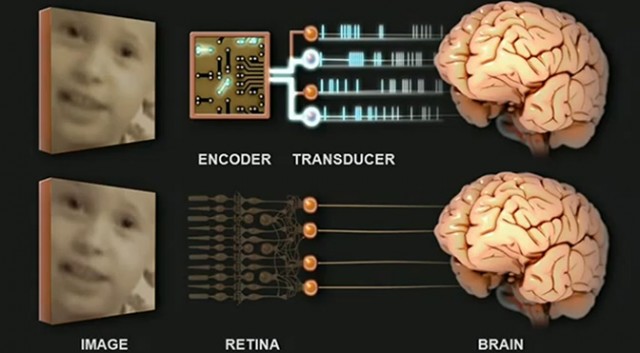
On the grand scale of things, we know so very little about the brain. Our thick-headedness isn’t quite cosmological in scale — we really do know almost nothing about the universe beyond Earth — but, when it comes down to it, the brain is virtually a black box. We know that stimuli goes in, usually through one of our senses, and motor neurons come out, but that’s about it. One thing you can do with a black box, however, is derive some semblance of a working model through brute force testing.
Take prosthetic arms, for example: We don’t have a clue about the calculations that occur in the brain to trigger arm muscle motor neurons, but that doesn’t stop us from slapping some electrodes onto a subject’s bicep muscles and measuring the electric pulses that occur when you tell him to “think about moving your arm.” By the same logic, a brain-computer interface can measure what our general cranial activity looks like when we’re thinking something and react accordingly, but it can only do this through training; it can’t actually understand our thoughts. Taking this one step further, though, Sheila Nirenberg of Cornell University has been trying to work out how the retina in your eye communicates with your brain — and judging by a recent talk at TEDMED (embedded below), it seems like she’s actually cracked it.
Robotic medical nanodevices controlled by wireless technology
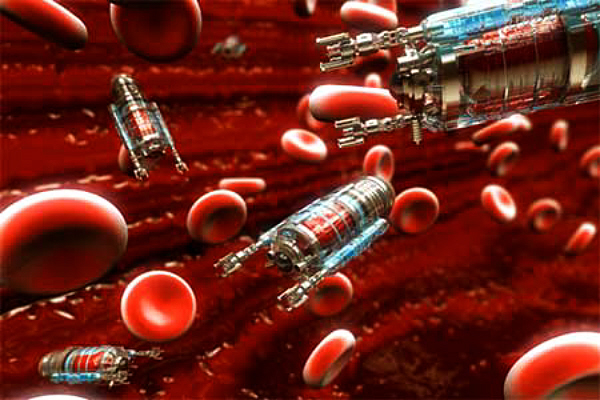
Technology has had a dramatic impact in healthcare. With the advancements of smartphones and tablets, and the number of medical devices, apps and peripherals being devised for them continues to grow everyday.
Recently, a Stanford engineer, Ada Poon, lead a project which has created tiny robotic medical devices that are powered by wireless technology.
According to Stanford University, the implantable machines are small enough to easily move through veins. These injectable nanobots can carry out medical tasks, gather diagnostics and even deliver drugs into the bloodstream.
Human Enhancement Technologies Alarming
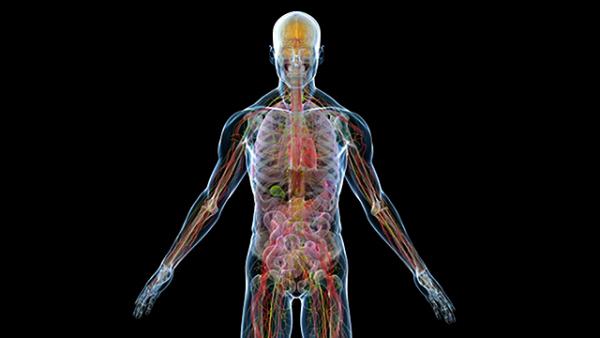
A collaborative team of scientists and ethicists raised serious concerns about the trend of augmenting humans with technology.
The Royal Society, along with the Academy of Medical Sciences, British Academy, and Royal Academy of Engineering, recently concluded a workshop called Human Enhancement and the Future of Work in which they considered the growing impact and potential risks of augmentation technologies.
In their final report, the collaborative team of scientists and ethicists raised serious concerns about the burgeoning trend, and how humanity is moving from a model of therapy to one in which human capacities are greatly improved. The implications, they concluded, should be part of a much wider public discussion.
ANALYSIS: Immortality for Humans by 2045
Specifically, the report expressed concerns about drugs and digital technologies that will allow people to work harder, longer, and smarter. The resulting implications to work and human values, they argue, may not necessarily be a good thing. It's quite possible, they argue, that employers will start to demand (either implicitly or explicitly) that employees "augment" themselves with stimulants such as Aderall.
Similarly, the workshop considered the potential for other smart drugs that can enhance memory and attention, as well as physical and digital enhancements such as cybernetic implants and advanced machine-interfacing technologies.
CONTACT LENS TECHNOLOGY: VIRTUAL REALITY PROJECTIONS

How’s this for a crazy story, one of the employees at Valve (the makers of Half-Life and the Steam online games store) has detailed how he tested virtual reality contact lenses. PCGamesN.com has the scoop:
“The technician made me sit in a chair that reminded me uncomfortably of a dentist’s chair, and asked me if I had ever worn contact lenses; I hadn’t. “It’s OK,” she said, “it’ll just take a minute or two for your eyes to adjust.” Indeed, after a few eye drops, my eyes adjusted to the transparent lenses and I almost forgot they were there.”
Once Varoufakis had the lenses in he says that he was handed a small box with a silver dial. Turning this dial increased the visibility of the image that was to be projected onto the lenses.
The technician motioned and I started turning the dial. Suddenly, I saw him (an alien)! He was eight feet tall, and stood out behind the technician. The first thing I noticed was his expressive red eyes and the scales he was covered in. Faint steam emanated from his nostrils. With slow, steady steps, he moved to the right, revealing all of himself from behind the technician, who was obviously having fun with my expression. As prepared as I was, the sight of the alien took my breath away. Even though I knew it was just a projection from the contact lenses onto my optical nerve, logic was having trouble defeating my instincts, which screamed at me to run toward the nearest exit.”
Carbon nanotube artificial muscle
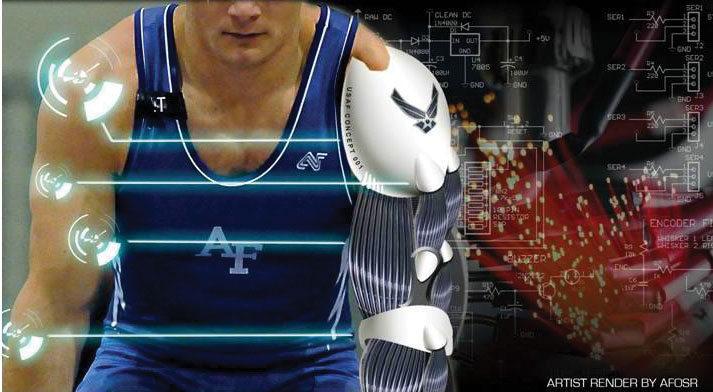
Research on a new kind of carbon nanotube artificial muscle for Air Force aerospace and space applications, conceived and invented, at the University of Texas at Dallas (UTD) is receiving primary financial support from the Air Force Office of Scientific Research (AFOSR).
Dr. Ray Baughman, director of the NanoTech Institute at UTD, and his team of researchers have been working on artificial muscles for more than twenty years. The current phase of his pioneering work stems from an exploratory research program supported by AFOSR program manager, Dr. B-L "Les" Lee since 2006. The team invented many new types, including electrochemical carbon nanotube and conducting polymer muscles, as well fuel-powered muscles. The latter, powered chemically by alcohol or hydrogen, operate similarly to natural muscles. But they are limited in that they cannot function at extreme temperatures and have low efficiencies for energy conversion.
So, here we have just a few of the things coming down the pike, Where will it stop? Not only are we seeing an increase of artificial and man made devices ready to either be implanted or to augment our bodies we have a parallel development of cloning and growing replacement organs.
How soon do you feel they'll start with increasing these replacement organs longevity, strength and abilities? You just know somebody, somewhere will say 'Hey, lets try this..."
Research team successfully grows human lung in lab

(Medical Xpress)—A team of researchers with the University of Texanderfful s has, for the first time, successfully grown a human lung in a lab. Project leads Dr. Joaquin Cortiella and Dr. Joan Nichols announced the landmark breakthrough to various members of the press this past week, describing the procedure and what was achieved.
Growing organs in the lab has become a reality in the past couple of years as scientists have learned more about stem cells and how they mature to become the cells that make up organs and other body parts. Windpipes, for example, have been successfully grown and implanted into human patients, and just last spring, a team of researchers at Massachusetts General Hospital in Boston successfully implanted lab grown kidneys into rats. In this new effort, the researchers have been focusing on growing one of the most complicated organs in the human body—the lungs.
I know this may scare some, intrigue others and probably bore the hell out of still others but I thought I'd post this here so as to put my thoughts about where we as a species are heading. In this case Science is truly riding on the heals of fiction and fast.
There is no denying it any longer
we are just entering a great time of innovative technological advancement
edit on 20-3-2014 by SLAYER69
because: (no reason given)
That contact lens vr got me way more psyched than anything else on this page...LOL
reply to post by SLAYER69
Oh my........
Slayer69 nice. Very nice indeed. I quickly scrolled through this and will be reading when and as soon as I get time and can concentrate fully.
From what I have skimped over it is sounding very interesting indeed.
Thanks.
Excellent thread and thanks for sharing. I agree that we are soon to embark on a new path here but I can't help but have all of the innovative ideas wasted on things used towards destruction.
Slayer69 you however have posted what can be achieved and how it can effectively transform a persons life who is suffering.
I hope that people don't use this to create the suffering.
Thanks again.
Oh my........
Slayer69 nice. Very nice indeed. I quickly scrolled through this and will be reading when and as soon as I get time and can concentrate fully.
From what I have skimped over it is sounding very interesting indeed.
Thanks.
Excellent thread and thanks for sharing. I agree that we are soon to embark on a new path here but I can't help but have all of the innovative ideas wasted on things used towards destruction.
Slayer69 you however have posted what can be achieved and how it can effectively transform a persons life who is suffering.
I hope that people don't use this to create the suffering.
Thanks again.
edit on 20-3-2014 by jazz10 because: Couldn't wait.
reply to post by LucidWarrior
I think there is something for everybody once they read it. I appreciate the feedback...
I think there is something for everybody once they read it. I appreciate the feedback...
As always, I love your posts.
As of right now, if I was injured but was able to receive a bio-mechanical limb or prosthetic, I would take it in a heart beat. If my liver was failing and they could 3D Print me one, I would take it in a heart beat. I find it highly possible and likely that THIS is the evolution AND De-evolution of mankind.
As of right now, if I was injured but was able to receive a bio-mechanical limb or prosthetic, I would take it in a heart beat. If my liver was failing and they could 3D Print me one, I would take it in a heart beat. I find it highly possible and likely that THIS is the evolution AND De-evolution of mankind.
reply to post by SLAYER69
I think these advances are wonderful.
But. . . .
I worry about the potential abuses. . . .
I think these advances are wonderful.
But. . . .
I worry about the potential abuses. . . .
This was a great read, thank you. I've been trying to keep up with the advancements and it is honestly getting noticeably harder to stay on the
cutting edge. Since reading Ray Kurzweils - "The Singularity is Near" I've had very high hopes for our development as a species. Ray clearly and
very specifically details the next step in our evolution, and it closely relates to your post. I highly recommend the book.
We have been looking foward while traveling backward through time. Soon the artificial will merge with the organic creating ourselves and the world
around us. Then we will find ourselves in a future world longing for the days of wild nature. Stopping at nothing to recreate a world that makes us
feel more in control. A sort of real life video game that can merge with any point in space time. great read
man
human (whoman)
woman (wombman)
man
human (whoman)
woman (wombman)
edit on 20-3-2014 by deadeyedick because: (no reason given)
beezzer
reply to post by SLAYER69
I think these advances are wonderful.
But. . . .
I worry about the potential abuses. . . .
Yes lets think about the abuses shall we? I think that transhumanism will shape our futures:
The fundamental ideas of transhumanism were first mooted in 1923 by the British geneticist J.B.S. Haldane in his essay Daedalus: Science and the Future, which predicted that great benefits would come from applications of advanced sciences to human biology — and that every such advance would first appear to someone as blasphemy or perversion, "indecent and unnatural". In particular, he was interested in the development of the science of eugenics, ectogenesis (creating and sustaining life in an artificial environment) and the application of genetics to improve human characteristics, such as health and intelligence.
There you have it...EUGENICS
They just need to pour all their money into one augment,
The ability to increase the human brain to process and remember knowledge, ie through traditional means or "uploading" it to the brain. Say - learning theoretical physics in an hour.
I would be all over that, the ability to download knowledge right to the brain.
The ability to increase the human brain to process and remember knowledge, ie through traditional means or "uploading" it to the brain. Say - learning theoretical physics in an hour.
I would be all over that, the ability to download knowledge right to the brain.
reply to post by SLAYER69
Good stuff Chief...
There is no denying it any longer
we are just entering a great time of innovative technological advancement
Yes, and most of you will miss the Bus on this, or at least a Future where Transhumanism is the norm, as you did not sign up for Cryonic Suspension services, as I had the foresight to do!!!
Winner, Winner, Chicken Dinner!
Good stuff Chief...
There is no denying it any longer
we are just entering a great time of innovative technological advancement
Yes, and most of you will miss the Bus on this, or at least a Future where Transhumanism is the norm, as you did not sign up for Cryonic Suspension services, as I had the foresight to do!!!
Winner, Winner, Chicken Dinner!
A most excellent thread Slayer!
I am amazed at how far technology and human understanding has come since the industrial revolution. If we continue down this path, without blowing ourselves up, we may achieve many more things once though impossible.
I am amazed at how far technology and human understanding has come since the industrial revolution. If we continue down this path, without blowing ourselves up, we may achieve many more things once though impossible.
AzureSky
I would be all over that, the ability to download knowledge right to the brain.
I too would be mighty tempted! Matrix for real lol...
The future could be so fantastic, yet somehow I think all the advances will be used to turn us ordinary folk into obedient robots, and the elites will
become superman.
AzureSky
They just need to pour all their money into one augment,
The ability to increase the human brain to process and remember knowledge, ie through traditional means or "uploading" it to the brain. Say - learning theoretical physics in an hour.
I would be all over that, the ability to download knowledge right to the brain.
I think I would be very wary of any sort of brain implant. The potential for abuse with that sort of technology is quite frightening. One day you are "brainloading" something from Wikipedia, a switch is flipped, and pow! You're a zombie... or, even worse... a politician...
Just for you Slayer:
The article from the Valve employee about the optical VR is extremely disturbing as such devices are EASILY tampered with. I can link you to a video where a simple bare-bones pineapple is used to steal passwords in seconds, and worse yet is that this sort of thing can take place over wifi. Who knows how easily these gadgets will be to crack or what sort of back doors will be built into them for use by the "hidden hand."
I love the idea of applying these technologies to allow the "disabled" to interact just like everyone else, but at the same time I am extremely hesitant to even consider replacing body parts that are in perfect working order as a "upgrade."
Unfortunately human history shows that when ever humanity can fall flat on its face and commit the worst conceivable atrocities . . . it will.
Hopefully we will learn from the mistakes we make before we really do irreversible damage.
-FBB
The article from the Valve employee about the optical VR is extremely disturbing as such devices are EASILY tampered with. I can link you to a video where a simple bare-bones pineapple is used to steal passwords in seconds, and worse yet is that this sort of thing can take place over wifi. Who knows how easily these gadgets will be to crack or what sort of back doors will be built into them for use by the "hidden hand."
I love the idea of applying these technologies to allow the "disabled" to interact just like everyone else, but at the same time I am extremely hesitant to even consider replacing body parts that are in perfect working order as a "upgrade."
Unfortunately human history shows that when ever humanity can fall flat on its face and commit the worst conceivable atrocities . . . it will.
Hopefully we will learn from the mistakes we make before we really do irreversible damage.
-FBB
edit on 20-3-2014 by FriedBabelBroccoli because: 101
I remember listening to my local talker a couple mornings ago. He was talking about the brain implants that could potentially just instantly look up
and deliver any knowledge you needed straight into your brain as soon as you needed it. They were comparing it to this:
My first thought was, "If we get so used to just having any existing knowledge and skill we want dumped into our head whenever we want it ... what happens if we just forget how to learn for ourselves? Will we actually stop learning how to, well, learn and acquire new knowledge for ourselves?"
My first thought was, "If we get so used to just having any existing knowledge and skill we want dumped into our head whenever we want it ... what happens if we just forget how to learn for ourselves? Will we actually stop learning how to, well, learn and acquire new knowledge for ourselves?"
reply to post by SLAYER69
Yea people get hyped up rfid chips lol. Forget that lol... The stuff will be living in your bloodstream and powered by your body. They will know everything about you, everything. You will be able to heal yourself, change your eye and hair color and yes even the way you look. Nanotechnology with the DNA id of your own living cells. Built right in. They will monitor your heart and clear and or repair it when needed. Your colon the same way. In essence on board doctors making you virtually immortal. If something does fail you simply grow the part you need.
This is already being done today. Nanotechnology is poised to change the world. Change color and shape of your car while you drive it. Your clothes will be tech and can make you invisible or change to suit the temp and weather conditions.
We literally won't recognize life in twenty years if we make it that long. Think sci-fi movies on steroids. Like elysium for instance. Problems are if you are poor you are just out of luck. I thought the whole point of tech was to get rid of the need for money lol.... Guess the greedy ones would rather die than give up their power and money.
The Bot
Yea people get hyped up rfid chips lol. Forget that lol... The stuff will be living in your bloodstream and powered by your body. They will know everything about you, everything. You will be able to heal yourself, change your eye and hair color and yes even the way you look. Nanotechnology with the DNA id of your own living cells. Built right in. They will monitor your heart and clear and or repair it when needed. Your colon the same way. In essence on board doctors making you virtually immortal. If something does fail you simply grow the part you need.
This is already being done today. Nanotechnology is poised to change the world. Change color and shape of your car while you drive it. Your clothes will be tech and can make you invisible or change to suit the temp and weather conditions.
We literally won't recognize life in twenty years if we make it that long. Think sci-fi movies on steroids. Like elysium for instance. Problems are if you are poor you are just out of luck. I thought the whole point of tech was to get rid of the need for money lol.... Guess the greedy ones would rather die than give up their power and money.
The Bot
reply to post by Starwise
We are heading into uncharted territory where these wonderful advancements could potentially be perverted into something we may not be able to deal with. We are right on the edge of this strange new world. If this is all presently coming to pass I wonder what the world will look like in 2114
We are heading into uncharted territory where these wonderful advancements could potentially be perverted into something we may not be able to deal with. We are right on the edge of this strange new world. If this is all presently coming to pass I wonder what the world will look like in 2114
new topics
-
A fix for the Trans players in sports
US Political Madness: 8 minutes ago -
Petition Calling for General Election at 564,016 and rising Fast
Social Issues and Civil Unrest: 3 hours ago -
Rep. Alexandria O. Cortez Says Forcing People to Use The Correct Bathroom is Dangerous.
US Political Madness: 9 hours ago -
Cooperation zones
World War Three: 10 hours ago
top topics
-
France gives Ukraine license to fire long-range missiles at Russia
World War Three: 14 hours ago, 9 flags -
Rep. Alexandria O. Cortez Says Forcing People to Use The Correct Bathroom is Dangerous.
US Political Madness: 9 hours ago, 5 flags -
Petition Calling for General Election at 564,016 and rising Fast
Social Issues and Civil Unrest: 3 hours ago, 5 flags -
Ok this is some BS now WTH
Rant: 12 hours ago, 4 flags -
Cooperation zones
World War Three: 10 hours ago, 3 flags -
Stalker 2 - Review from a Veteran
Video Games: 17 hours ago, 2 flags -
A fix for the Trans players in sports
US Political Madness: 8 minutes ago, 1 flags
active topics
-
Petition Calling for General Election at 564,016 and rising Fast
Social Issues and Civil Unrest • 16 • : gortex -
Biden's "Reckless" Decision To Escalate Russia-Ukraine War
World War Three • 125 • : Xtrozero -
A fix for the Trans players in sports
US Political Madness • 0 • : network dude -
Well, here we go red lines crossed Biden gives the go ahead to use long range missiles
World War Three • 340 • : Xtrozero -
Jaguar Rebrand Video Causes "WTF?" Moment - Seriously Weird
Automotive Discussion • 32 • : gortex -
Well we know Putins ICBMs won't fail in their silos
World War Three • 213 • : Xtrozero -
Rep. Alexandria O. Cortez Says Forcing People to Use The Correct Bathroom is Dangerous.
US Political Madness • 21 • : UpIsNowDown2 -
Congress 2024 - We do not want me in our ladies rooms
US Political Madness • 21 • : TheSingleBillie -
Results of the use of the Oreshnik missile system in Dnepropetrovsk
World War Three • 166 • : Oldcarpy2 -
Cooperation zones
World War Three • 14 • : nugget1
